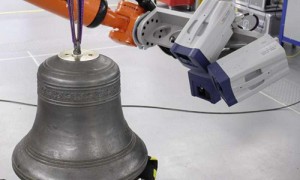Bells are a popular source of festive delight during the Christmas period and now beautiful images showing in unprecedented detail how bells vibrate to make a harmonious sound have been produced by the commercial team at the University of Leicester’s Advanced Structural Dynamics Evaluation Centre (ASDEC).
 Working with John Taylor & Co, a company of bell founders that can trace their origins back to the 14th century, the team scanned the structural dynamics of two large bells using ASDEC’s robotised 3D laser vibrometry system at approximately 4,000 measurement locations, providing visual data that would be unimaginable with traditional instrumentation.
Working with John Taylor & Co, a company of bell founders that can trace their origins back to the 14th century, the team scanned the structural dynamics of two large bells using ASDEC’s robotised 3D laser vibrometry system at approximately 4,000 measurement locations, providing visual data that would be unimaginable with traditional instrumentation.
ASDEC’s unique structural dynamic measurement can be used on its own or to correlate against finite element analysis (FEA) computer modelling – a computerised method for predicting how a product reacts to real-world forces, vibration, heat, fluid flow, and other physical effects.
Martin Cockrill, technical specialist at ASDEC said: “Traditional techniques at best can only provide a coarse glimpse into the murky world of structural dynamics.
“By utilising ASDEC’s advanced robotised laser system we were able to reveal the beauty of the bells vibration in amazing detail. A thorough, accurate measurement of any structure empowers designers to correlate their virtual models and rapidly move forward with concepts and designs that are grounded in fact.”
Bells are amongst some of the earliest known musical instruments, using mechanical resonance to produce a powerful harmonious sound. The art of bell founding has been present in Europe since the 4th or 5th century.
In 17th century Britain, the rise of ‘change ringing’, where mathematical patterns are rung on a set of bells, propelled bell manufacturing to industrial scales.
In English style change ringing, a bell is normally manufactured as part of a set, or peal, containing up to 16 bells, tuned to a diatonic major scale, making the relative pitch of the bell to the peal more noticeable.
When a bell is struck, the impact causes a number of different vibrations or modes. The frequency and intensity of these modes is predominantly affected by the profile of the bell. For every bell manufacturer, the profile they use is unique and gives the characteristic timbre associated with them.
In bell tuning language the initial note that is heard as a bell is struck is the ‘Prime’, and the note that persists on afterwards is the ‘Hum’ (an octave below the prime) but the most relevant harmonics are the ‘partials’ described in ratio terms of the ‘Nominal’, the variants are Prime (strike note), Tierce (minor third), Quint (perfect Fifth), Octave Nominal. The shapes that the bell makes at these frequencies remain the same no matter what note the ‘Nominal’ is tuned to.
John Taylor & Co. can trace their bell founding origins back to the 14th century and have operated at their current location in Loughborough since 1839. Their bells are traditionally cast from a bronze alloy in a size appropriate for the desired pitch, and finely tuned using a lathe and calibrated tuning forks. John Taylor bells are recognised as having a colourful and rich timbre whilst retaining a pure tone.
Mike Semken, director, John Taylor and Co. Bell Foundry says: “I am very impressed with the finished images and results and I am very pleased to see that they match my own FEA work very closely.”
ASDEC, which functions both as a commercial operation and as a research facility, is the UK’s first commercial robotised 3D scanning laser vibration measurement and modal analysis centre which works closely with the University of Leicester’s Department of Engineering.
The Centre is directed by Sarah Hainsworth, professor of materials and forensic engineering at the department of engineering, and has been developed by the University of Leicester and funded by grants from the Government’s Regional Growth Fund and the European Regional Development Fund.
University of Leicester
Tel: 0116 252 2522